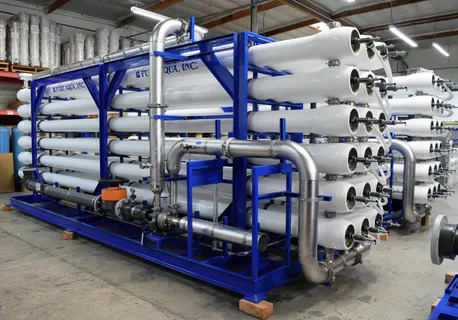As global freshwater resources continue to dwindle due to overuse, climate change, and rapid urbanization, seawater desalination has emerged as a vital solution. Especially in water-scarce regions, Industrial Seawater RO Desalination Systems (Reverse Osmosis) are helping industries secure reliable sources of clean water. However, while desalination offers a practical answer to water scarcity, it also brings significant environmental consequences if not managed responsibly.
This blog explores the environmental impact of industrial seawater desalination and provides actionable mitigation tips to help balance industrial growth with ecological preservation.
Understanding Industrial Seawater RO Desalination Systems
Industrial Seawater RO Desalination Systems utilize high-pressure pumps to force seawater through semi-permeable membranes. These membranes filter out salts, minerals, and impurities, producing fresh water suitable for industrial processes, cooling systems, manufacturing, and even potable use in some cases.
These systems are favored for their efficiency and scalability. However, their widespread use has led to concerns around energy consumption, brine disposal, and marine ecosystem disruption—issues that must be addressed for sustainable growth.
Environmental Impacts of Industrial Desalination
1. High Energy Consumption and Carbon Emissions
One of the most critical environmental concerns of Industrial Seawater RO Desalination Systems is the substantial energy they consume. RO systems typically require large amounts of electricity to operate high-pressure pumps, contributing to increased carbon emissions—especially when powered by fossil fuels.
Unless renewable energy sources like solar or wind are integrated, the carbon footprint of desalination can undermine efforts to combat climate change.
2. Brine Disposal and Marine Pollution
Desalination produces a byproduct known as brine—highly concentrated saline water often containing treatment chemicals like chlorine, antiscalants, and metals. If this brine is discharged directly into the ocean without proper dilution, it can:
- Increase seawater salinity levels
- Lower oxygen concentrations
- Harm marine organisms and habitats
Continuous disposal of untreated brine can lead to long-term ecological imbalance in coastal regions.

3. Intake of Marine Life
Most Industrial Seawater RO Desalination Systems extract seawater directly from the ocean through intake pipes. Unfortunately, these systems often trap and kill small marine organisms like plankton, fish larvae, and eggs. While individually small, the cumulative impact on biodiversity can be significant, especially in sensitive marine zones.
4. Chemical Use and Contamination
Desalination processes often involve chemicals for membrane cleaning and pre-treatment. Improper handling or discharge of these chemicals into the environment can lead to soil and water contamination, affecting both human and ecological health.
Mitigation Tips for Reducing Environmental Impact
While desalination presents environmental challenges, several strategies can help industries mitigate their footprint and embrace sustainable practices:
1. Integrate Renewable Energy Sources
Switching to renewable energy like solar, wind, or geothermal power to operate Industrial Seawater RO Desalination Systems can drastically reduce carbon emissions. Some industries are even adopting hybrid systems that combine traditional energy with renewable power sources.
2. Optimize Energy Efficiency
Technological innovations such as energy recovery devices (ERDs) and high-efficiency pumps can reduce energy consumption by up to 60%. Regular maintenance, proper system sizing, and optimized membrane configurations further contribute to operational efficiency.
NOTE : Industrial Seawater RO Desalination Systems in Kenya are transforming water accessibility for industries. These systems convert seawater into high-quality freshwater, ensuring a sustainable supply. From manufacturing to agriculture, businesses benefit from reliable water solutions. Investing in advanced desalination technology is key to overcoming Kenya’s water scarcity challenges.
3. Sustainable Brine Management
Instead of direct discharge into the ocean, industries can implement:
- Brine dilution techniques using treated wastewater
- Zero liquid discharge (ZLD) systems to recover valuable minerals
- Deep-sea diffusers that disperse brine over a wider area to reduce salinity buildup
These practices help protect marine life while potentially turning waste into valuable resources.
4. Use Eco-Friendly Intake Systems
Using subsurface intake systems or screening technologies can reduce the mortality of marine life during water extraction. These systems filter seawater through sand or gravel beds, minimizing the intake of organisms and suspended solids.
5. Implement Advanced Monitoring and Compliance
Real-time monitoring of discharge quality, energy usage, and marine conditions ensures that operations remain within environmental regulations. Regular audits, third-party assessments, and transparency in reporting can also build public trust and promote industry accountability.
6. Reuse and Recycling
Industries can design closed-loop water systems that reuse a portion of the desalinated water for non-potable purposes like cleaning, cooling, or irrigation. Recycling reduces overall freshwater demand and minimizes waste generation.
The Future of Desalination: Innovating for Sustainability
With water demand continuing to rise, innovation is key. Research into forward osmosis, graphene-based membranes, and solar-powered RO units is offering promising alternatives to traditional systems. Meanwhile, AI and IoT technologies are improving operational control, reducing energy waste, and predicting maintenance needs before breakdowns occur.
Collaborative approaches—where governments, industries, and environmental groups work together—are also essential in shaping the future of sustainable desalination.
Don’t Forget to check out : The UAE’s interior design trends inspired by contemporary folding-style doors
Conclusion: Choose Responsible Partners in Desalination
Desalination will remain a cornerstone in global water strategy, especially for industrial and coastal development. But it must evolve with the environment in mind. By investing in efficient, eco-conscious Industrial Seawater RO Desalination Systems, businesses can meet their water needs while minimizing harm to the planet.
When seeking dependable and sustainable desalination solutions, BLACKWOOD HODGE stands out as a trusted industry leader. With advanced technologies, a commitment to environmental responsibility, and a proven track record, BLACKWOOD HODGE offers systems that not only deliver pure water—but also a cleaner, greener future.
